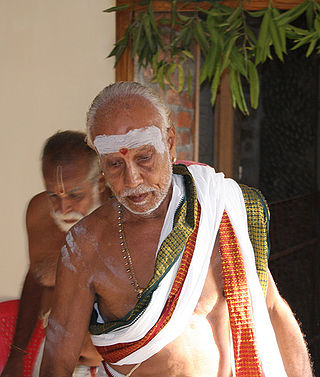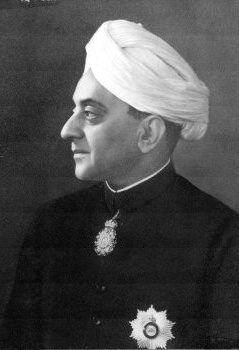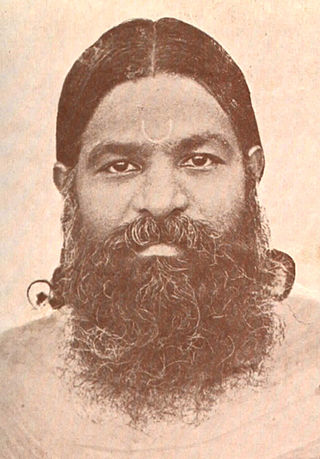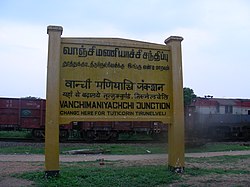
Vande Mataram is a poem written in Sanskrit and Sanskritised Bengali by Bankim Chandra Chatterjee in the 1870s. The first two verses of the poem were adopted as the National Song of India in October 1937 by the Congress.

Iyers are an ethnoreligious community of Tamil-speaking Hindu Brahmins. Most Iyers are followers of the Advaita philosophy propounded by Adi Shankara and adhere to the Smarta tradition. This is in contrast to the Iyengar community, who are adherents of Sri Vaishnavism. The Iyers and the Iyengars are together referred to as Tamil Brahmins. The majority of Iyers reside in Tamil Nadu, India.

C. Subramania Bharati was a Tamil writer, poet, journalist, Indian independence activist, social reformer and polyglot. He was bestowed the title "Bharati" for his excellence in poetry. He was a pioneer of modern Tamil poetry and is considered one of the greatest Tamil literary figures of all time. He is popularly known by his mononymous title "Bharati/ Bharathiyaar," and also by the other title "Mahakavi Bharati". His numerous works included fiery songs kindling patriotism during the Indian Independence movement. He fought for the emancipation of women, against child marriage, vehemently opposed the caste system, and stood for reforming society and religion. He was also in solidarity with Dalits.

Dewan Bahadur Sachivottama SirChetput Pattabhiraman Ramaswami Iyer, popularly known as Sir C. P., was an Indian lawyer, administrator and politician who served as the Advocate-General of Madras Presidency from 1920 to 1923, Law member of the Executive council of the Governor of Madras from 1923 to 1928, Law member of the Executive Council of the Viceroy of India from 1931 to 1936 and the Diwan of Travancore from 1936 to 1947. Ramaswami Iyer was born in 1879 in Madras city and studied at Wesley College High School and Presidency College, Madras before qualifying as a lawyer from the Madras Law College. He practised as a lawyer in Madras and succeeded S. Srinivasa Iyengar as the Advocate-General of the Madras Presidency. He subsequently served as the Law member of the Governor of Madras and of the Viceroy of India before being appointed Diwan of Travancore in 1936.

Vallinayagam Olaganathan Chidambaram Pillai , also known as Kappalottiya Tamizhan, was an Indian freedom fighter and a prominent leader in the Indian independence movement. He founded the Swadeshi Steam Navigation Company in 1906 to compete against the monopoly of the British India Steam Navigation Company (BISNC). He launched the first indigenous Indian shipping service between Tuticorin (India) and Colombo with the Swadeshi Steam Navigation Company (SSNC), competing against British ships. Tuticorin Port Trust, one of India's thirteen major ports, is named after him. Once a member of the Indian National Congress, he was later charged with sedition by the British government and sentenced to life imprisonment, and his barrister license was revoked.
The Revolutionary movement for Indian Independence was part of the Indian independence movement comprising the actions of violent underground revolutionary factions. Groups believing in armed revolution against the ruling British fall into this category, as opposed to the generally peaceful civil disobedience movement spearheaded by Mahatma Gandhi.
Ottapidaram is a small town in Thoothukudi district and headquarters of Ottapidaram taluk. Ottapidaram is a tourism centre with accessibility to many places in Tamil Nadu. Thoothukudi or Tirunelveli can be easily accessed from anywhere and Ottapidaram is very close to these two places. The great freedom fighter V. O. Chidambaram Pillai called VOC hails from Ottapidaram. VOC is also called as "Kappalottiya Tamizhan" because he launched one of the first shipping companies, Swadeshi Steam Navigation Company which operated ship between Tuticorin and Colombo against the British during the rule in India.

Varahaneri Venkatesa Subramaniam Aiyar, also known as V. V. S. Aiyar, was an Indian revolutionary from Tamil Nadu who fought against British colonial rule in India. His contemporaries include Subramanya Bharathi and V.O. Chidambaram Pillai, who subscribed to militant forms of resistance against the British colonial government. He also exchanged ideas with V. D. Savarkar during his stay at India House in London. He went into exile in Pondicherry, then under French rule, when his militant activities attracted a warrant for his arrest from the British colonial government.

Sengottai is a town in the Tenkasi district, of Tamil Nadu, India. It is the gateway to southern Tamil Nadu and Kerala. Spread over an area of 2.68 km2 with a population of over 26,823, the economy of the town and Sengottai Taluk revolves around the cultivation of rice,coconut,Mango,clove and pepper. Sengottai is well known in Tamil Nadu as a major market of Dosa kal. This town has lot of Black smith shops.

Ganapathy Dikshitar Subramania Iyer was a leading Indian journalist, social reformer and freedom fighter who founded 'The Hindu' English newspaper on 20 September 1878. He was proprietor, editor and managing director of The Hindu from 20 September 1878 to October 1898. Tamil language newspaper 'Swadesamitran' was also founded by him in 1882.

Mandayam Parthasarathi Tirumal Acharya was an Indian nationalist, communist and anarchist who was among the founding members of the Communist Party of India. In a long political and activist life, Acharya was at various times associated with India House in London and the Hindu-German Conspiracy during World War I when, as a key functionary of the Berlin Committee, he along with Har Dayal sought to establish the Indian Volunteer Corps with Indian prisoners of war from the battlefields of Mesopotamia and Europe. Acharya subsequently moved in 1919 after the end of the war to the Soviet Union, where he was one of the founding members of the Communist Party of India at Tashkent. However, disappointed with the Communist International, Acharya returned to Europe in the 1920s where he was involved with the League against Imperialism and subsequently was involved with the international anarchist movement.

Kalakkad S. Ramanarayana Iyer was a Carnatic musician and composer born in Kalakkad, Tirunelveli District, Tamil Nadu, India. He was also awarded the Kalaimamani award by the Government of Tamil Nadu marking his dedication and service.

A. Vaidyanatha Iyer, also known as Madurai Vaidyanatha Iyer or Ayyar was an Indian activist, politician and freedom-fighter who spearheaded the temple entry movement in Madras Presidency in 1939.
The Indian independence movement had a long history in the Tamil-speaking districts of the then Madras Presidency going back to the 18th century.

Robert William d'Escourt Ashe was the acting Collector and District magistrate of Tirunelveli district in Madras Presidency during the British Raj. Ashe had played a significant part in bringing about the closure of the Swadeshi Steam Navigation Company, started by V.O. Chidambaram Pillai to take on the British India Steam Navigation Company that had for long monopolised trade in the southern part of the Bay of Bengal. He had also been responsible for charging V.O.Chidambaram Pillai and a colleague, Subramanya Siva, for which they were convicted. On 17 June 1911 Ashe was assassinated by Vanchinathan at the Maniyachi railway junction, between Tirunelveli and Tuticorin. After the shooting, Vanchinathan ran along the platform and took cover in the latrine. Some time later he was found dead, having shot himself in the mouth. Vanchi was accompanied by a youth named Sankara Krishna Aiyar who ran away, but was afterwards caught and convicted. Ashe was the first and only colonial official to be assassinated in South India during the Indian independence movement. The British government built a memorial for him at Tuticorin in 1913. That memorial is currently in dilapidated condition.

Vanchi Maniyachchi Junction railway station is a junction railway station in Maniyachchi of Thoothukudi district in the Indian state of Tamil Nadu. Services from north of the station pass through the station to proceed southwards to Tirunelveli and eastwards to Thoothukudi, as these branchings make the station, a junction.

Maniyachchi is a township in the Thoothukudi district of Tamil Nadu situated approximately 40 km west of Thootukudi and some 30 km from Palayamkottai and Kovilpatti.

The Kollam–Sengottai railway line is a railway line in South India which connects Kollam Junction in Kerala state and Sengottai in Tamil Nadu. The Quilon–Shencottah railway line was the first railway line in the erstwhile Travancore state and is more than a century old. The Kollam–Sengottai section is part of the Kollam–Chennai metre-gauge rail route commissioned by the British in 1904. The line has been completely converted to broad gauge and is now fully operational from Kollam Junction to Shengottai.It is the important cargo transportation line connecting Vizhinjam container port and South indian States.
The Swadeshi Steam Navigation Company (SSNC) was one of the first indigenous Indian shipping companies set up during the Indian independence movement. It was started in 1906 by V. O. Chidambaram Pillai to compete against the monopoly of the British India Steam Navigation Company (BISNC). It sailed ships between Tuticorin and Colombo until it was liquidated in 1911.

Sengottai railway station is a railway station serving the town of Sengottai in Tamil Nadu, India. It lies on Kollam–Sengottai branch line and Sengottai- Virudunagar line. The Kollam–Shencottah railway line is the first railway line in erstwhile Travancore state and is more than a century old. The Kollam–Sengottai section is part of the Kollam–Chennai metre-gauge rail route commissioned by the British during 1904. The line which was metre gauge has been completely converted into broad gauge and train services started.
















